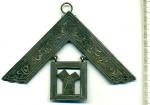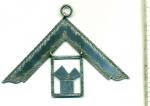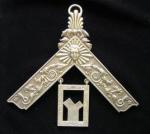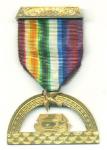
wm5806
Past Contributor-
Posts
230 -
Joined
Content Type
Profiles
Forums
Blogs
Gallery
Events
Store
Everything posted by wm5806
-
Use the 'Edit' -> 'Full edit' option in the lower RH corner of the post. WM5806
-
A less noble but no less decorated Past Grand Deacon of the Grand Lodge of Mark Master Masons [attachmentid=45030]
-
Hi Gilbert Sorry, don't know a great deal about them myself, although I think their origins are here in England. There are a few websites, the most 'official' looking is here. Similarly, lot of Masonic 'presence' on the web. Funny, really, for an organisation like Freemasonry that's supposed to be 'secret', why there's so many websites Kindest regards WM5806
-
Hi Gilbert, Regret to say it's not Masonic. I think it's from the Royal Antediluvian Order of Buffaloes, an entirely separate fraternal organisation, but one whose regalia is often confused with that of Freemasonry. Hope that helps, WM5806
-
Hi Gilbert Any chance of a picture, please? Have to say that it doesn't sound as though it has its origins in English Freemasonry. Regards WM5806
-
Thanks Humber, Very interesting idea and can see where you're coming from. I had certainly not even thought about it having any origins other than Masonic, so will learn my lesson and keep my mind open! However, I still think it's most likely Scottish or early English RAM, although your suggestion has introduced that important 'element of doubt' in my mind. The only mention I can find of the "Companions of the Ark" is here, but unfortunately no (relevant) jewels are pictured. Nor is there any reference in Victoria Solt Dennis' book "Discovering Friendly and Fraternal Societies: Their badges and regalia" (2006, published by Shire). I have a friend who's an avid collector of Buffs regalia, so will ask him and report back. Regards, WM5806
-
You never know with the American Brethren that are also active on this board! Alternatively, the Grand Lodge of Free and Accepted Masons of the State of New Hampshire have their own website with a 'Contact Us' page, by which means you may be able to get information on the original recipient. Good luck and let us know how you get on. Kind regards WM5806
-
True enough, although there are jewels other than those for service as Worshipful Master. One of the jewels I wear in the Craft degree is that to indicate I am a member of the Thomas Harper Lodge (No. 9612), as officially sanctioned by UGLE. During the summer I shall become a Founder member of another Lodge, entitling me to wear a Founder's jewel for that Lodge. Although not seen very often these days, there is a specific jewel to indicate membership of the Quatuor Coronati Lodge Correspondence Circle (established in the late 19th Century) which, should I ever decide to join, I shall wear that one too. Similarly, when I am exalted into the Royal Arch, I shall be entitled (and encouraged) to wear the Companions' jewel. When I attend my Mark Lodge, I wear the jewel of the Order, a Centenary jewel for my Mark Lodge and the jewel to indicate membership of the Honourable Fraternity of Royal Ark Mariners. There is a further jewel being issued later this year to mark (no pun intended) the 150th Anniversary of Mark Grand Lodge. So, there are quite a few jewels in English Freemasonry, but not nearly so many are worn these days as in the late 19th and early 20th Centuries - see some of my previous posts on this board. Kind regards
-
Another one! This is hallmarked for London 1888, although presentation inscription is from the 1940s. A further square has been added to it for a second recipient of the same surname (father/son ??), the hinge for which can just be seen protruding either side below the loop. Measures a more modest 120mm across the points. [attachmentid=35081]
-
Hallmarked Birmingham 1848. Measures 140mm across the outer points of the square. Note the thin border around the problem. [attachmentid=35080]
-
Here's a couple of pictures of some older Past Master collar jewels from (I'm pretty sure) the English Constitution. The one with all the intricate mouldings is hallmarked silver by Spencer and dated 1916, while the other one is unmarked and undated, but almost certainly older than the first. I shall try to find a picture of their modern equivalent, so that even those not familiar with the design can decide which they prefer... [attachmentid=34472] [attachmentid=34473]
-
A beauty from a recent auction: [attachmentid=32621] Inscription on reverse: Brother R. Mee Raikes, appointed Junior Grand Warden of the United Grand Lodge of Ancient Free and Accepted Masons of England AL 5837 AD 1833.
-
Hello Nack Just as Freemasonry is spread throughout the world, so are its medals and jewels. Firstly, let me draw a distinction between the two: a medal (to Freemasons) is a piece struck to commemorate a certain event or its anniversary, and resembles a coin, whereas a jewel is intended to be worn and will indicate the wearer's Masonic rank, membership of a certain Lodge, support for a particular fundraising cause or to commemorate an event. As such, there are many medals and jewels. The majority of jewels would appear to be from English Constitution Lodges, although there are many American ones too (see a popular internet auction site for examples). However, most medals would appear to be from mainland Europe, being struck in the 18th and 19th Centuries. Interestingly, one of the earliest books to be written about them was by an American numismatist, WTR Marvin, in 1880. WM5806
-
On a serious note, there are - I believe - some quite distinct differences between various signs and rituals used in Masonry as practised in different parts of the UK, never mind the rest of the world. That being so, what is considered 'correct' here in England might not be recognised at all in certain parts of Scotland. Like the age of the book, there's no definitive answer...
-
I wouldn't know if it was all true anyway, not being in some of the other degrees that it describes. However, you should be aware that some of these 'exposures' are more (in)accurate than others, and I can see some inaccuracies from the scans, so don't take it to heart! If you want to know more you'll have to join!
-
Hi Stephen Thanks for your reply. Your comments are valuable when you say that the book 'feels' older than that. Perhaps might be worth finding out more about the publishers? William Reeves was recorded as being at 83 Charing Cross Road at least between 1907 - 1930, but what if they also pre-dated the Reeves & Turner partnership? If you can get your hands on a good run of trade directories for London (perhaps something like 'Kelly's') in a big library and track them down, then you might get an earlier date which would fit better with the 'feel'. Sorry not to have been able to provide a definitive answer. Good luck! WM5806
-
Hi Stephen Difficult to date precisely, as you can imagine. However, I've narrowed it down a fair bit: - The book itself is generally regarded as having been written by Avery Allyn. - Various printing dates, earliest found was 1831, published by John Clarke in Philadelphia - Other editions: -Shebbear, 1835 and 1848, Devon -William Gowans, 1865, New York -Reeves & Turner, 1896, Strand - William Reeves was recorded as being at 83 Charing Cross Road at least between 1907 - 1930. As it was Reeves AND Turner in 1896, I would suggest it was published AFTER 1896, and maybe as late as 1930 or after that even. Hope that's some use, sorry not to have been more precise. Does that fit in with how old the book 'feels'? Regards WM5806
-
Pretty certain it's an ordinary member's jewel, although it MAY be for a PCN.
-
Hi Alan You're absolutely right - as far as the English Constitution goes. I have an idea that the Scots have a slightly different approach and I enclose a pic of a more modern, silver-gilt jewel (1904, Richard Spencer) from the Scottish RAM degree to go some way to illustrating this. Kind regards WM5806 [attachmentid=31788]
-
Hi Alan I'm fairly happy that the jewel is from the Sottish RAM degree, rather than Grand Rank, the jewel for which is known in these parts - by those that wear it - as the 'flying b*llock'; it was just the ribbon throwing me.
-
Thanks Alan, The design made me think of a Chapter apron, but I didn't think as far as the ribbon being taken from a Chapter apron. I asked the vendor whether he knew if the ribbon was original but, unfortunately, he said it had come from a house clearance with a load of other (non-Masonic) items and couldn't really tell me. The ribbon bars are similar to those illustrated in a THLamb's catalogue from 1888. Other than that, I really don't have any idea of its origins.... WM5806
-
Hi Rick Sorry, I just noticed that no-one had replied to your original post. Working on the principle of being "better late than never", I shall try to address your points: - Yes, many Lodges may have their own crest, logo, design or what ever you wish to call it. Often this will be displayed on their jewels, banner and letterhead. - The crests on Stewards jewels are often those of the English/Welsh Masonic Province (similar I suppose to your states) which is organising the Festival for that year. The Festivals were massive fundraising campaigns to support the Masonic charities, each Province taking a turn to rganise them. The Institutions, as you rightly guessed, were national but the emblems on the jewel were local - if that makes sense? - the Lodge which bears the number 3106 is Thoresby Lodge, meeting in Nottingham. However, would have to see the jewel to best decide whether it was the Lodge number, or something else. Kindest (belated) regards WM5806
-
Humber, Please don't take this the wrong way, but reference to the MQ Magazine you highlighted says: I'm a little confused by my misunderstanding WM5806
-
-
BRITISH MASONIC MEDALS FOR SALE IN ROMANIA
wm5806 replied to Kev in Deva's topic in Masonic Medals & Jewels
Hello Kev The first one and third one are Masonic, the second is from the Buffaloes and the fouth, I think, is a military medal - possibly an Iron Cross, but I do not know much about the military medals. In my opinion, his prices for the Masonic items are high compared to eBay in Britain, where they would probably sell for between ?10 - ?20 (Euro 15,00 - 30,00). Cannot advise on the other two. WM5806









